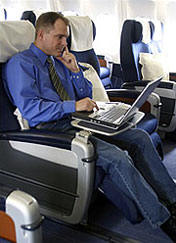
NEWSROOM
 |
NEWSROOM |
|
|
|
|
|||
|
Cell Phones
WiFi On Airplanes What You Didn’t Know
|
||||
 |
November 10, 2009,
If you’ve flown with a commercial airline, you know the drill. Turn off
all pagers, electronic games, MP3 and CD players, laptops and the like
once the cabin door is closed, until the plane gets above 10,000 feet.
No using cell phones at any time while the plane is in the air. But do
you know the real reasons why you have to follow these rules?
There are still
unknowns about the radio signals that portable electronic devices (PEDs)
and cell phones give off. These signals, especially in large quantities
and emitted over a long time, may unintentionally affect aircraft
communications, navigation, flight control and electronic equipment.
Federal Aviation
Administration regulations prohibit use of most portable electronic
devices aboard aircraft, but they specifically exempt portable voice
recorders, hearing aids, heart pacemakers and electric shavers because
they don’t give off signals that might interfere with aircraft systems. |
|||
|
The regulations also let airlines independently determine if passengers
can use PEDs not specifically mentioned by the rules. An airline must
show a device does not interfere with safe operation of the aircraft
during all phases of flight. In its oversight capacity, the FAA ensures
that the operator complies with regulations by reviewing the results of
the carrier’s tests and its analysis of pertinent data.
The FAA has issued guidance to airlines letting passengers turn on most
PEDs after the plane reaches 10,000 feet. At a lower altitude, any
potential interference could be more of a safety hazard as the cockpit
crew focuses on critical arrival and departure duties.
Cell phones (and other intentional transmitters) differ from most PEDs
in that they send out signals strong enough to be received at distances
far away from the user.
Since 1991, the Federal Communications Commission (FCC) has banned the
inflight use of 800 MHz cell phones because of potential interference
with ground networks. This ban requires that in addition to the testing
the FAA requires to show non-interference to the airplane systems, an
airline would also need to apply for an exemption to the FCC rule before
it could allow cell phone use inflight. The FCC proposed modifying this
ban in 2004, but subsequently withdrew the proposal based on the
comments it received. |
||||
|
Even if the FCC ever rescinds its ban, FAA regulations would still
apply. Any installed equipment would be subject to FAA certification,
just like any other piece of hardware. The air carrier would have to
show that the use of a particular model phone won’t interfere with the
navigation and communications systems of the particular type of aircraft
on which it will be used.
Today, airlines may let passengers use newer-model cell phones in what’s
called "airplane" mode, which essentially disables the transmission
function so they can't make calls. This mode lets users do other things,
such as play games, check an address or look at the phone’s calendar.
FAA guidance does let airlines allow cell phone calls once the plane has
landed and is taxiing to the gate.
From 2003 to 2006, the RTCA — an organization the FAA sometimes asks to
help study technical matters that affect policy and regulatory decisions
– looked at the issue of electromagnetic interference from intentionally
transmitting PEDs, such as cell phones and WiFi transmitters in laptops.
Air carriers collected data to support the RTCA’s work.
The final RTCA report said there is insufficient information to support
a wholesale change in policies that restrict use of PEDs. But the group
did publish thoroughly detailed processes by which operators and
manufacturers can assess the risk of PED interference with aircraft
systems, and similarly detailed guidelines for certification of such
products, if it is requested from the FAA.
WiFi in the sky, over the last couple of years, airlines have responded
to travelers’ requests for inflight Internet access by installing WiFi
systems that passengers can access (for a fee) using their laptop
computers, Blackberries and other devices with a WiFi chip.
For each model of aircraft a WiFi system is to be used on, a
manufacturer must get FAA certification for the system, and the airline
must get FAA operational approval. The approvals include testing to show
the equipment performs its intended function and doesn’t interfere with
any aircraft systems during all phases of flight. Typically, airborne
WiFi equipment mimics its earthbound counterparts: routers, ethernet
cables, access ports and other communications hardware, all permanently
installed in the airplane.
While passengers are welcome to access the web, |
| ©AvStop Online Magazine Contact Us Return To News |